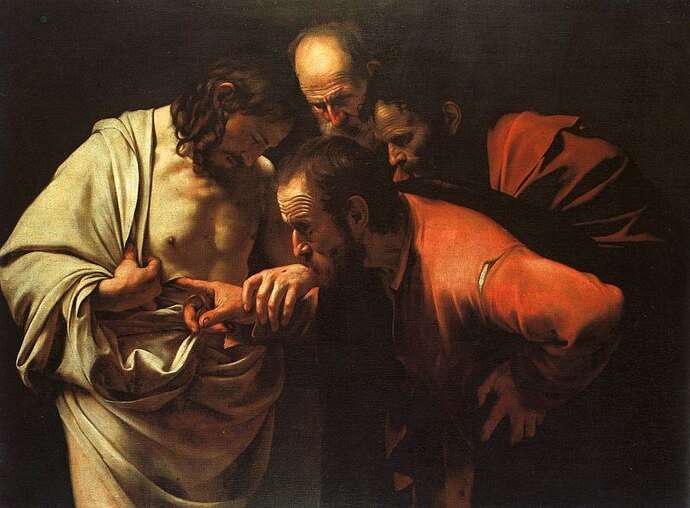Who was Saint Thomas?
Saint Thomas was one of the twelve apostles chosen by Jesus Christ, known both for his courage and for his famous doubt. His name, “Thomas,” comes from Aramaic and means “twin”—and in Greek he is also called Didymus, which has the same meaning. Although the Gospels do not provide many details about his life before Jesus called him, we know that he left everything behind to follow the Master, like the other apostles.

The Apostle of Wavering Faith
Thomas became especially known for the episode that occurred after the Resurrection. When the other disciples told him they had seen the risen Lord, he said he would not believe unless he first saw and touched the wounds of Jesus. Eight days later, Christ appeared again and invited Thomas to touch His wounds. At that moment, Thomas made one of the greatest professions of faith ever recorded in the Bible: “My Lord and my God!” (John 20:28). This declaration not only changed his own story but became a milestone in Christian faith, showing that even doubt can lead to deeper belief.
What was his life like after Jesus left?
After the Ascension of Jesus, Thomas’s life changed completely. Filled with the Holy Spirit, he dedicated himself to preaching the Gospel. According to ancient traditions, he went beyond the boundaries of the Roman world, becoming a great missionary in distant lands.
The Mission in Persia and India
The most consistent tradition tells that Saint Thomas first preached in the region of Persia, modern-day Iran, and Mesopotamia, where he founded Christian communities. But it was especially in India that his mission grew in strength and fame. Around the year AD 52, Thomas is said to have landed at the port of Muziris, now called Kodungallur, in the state of Kerala, in southwestern India. There he found already-established Jewish communities, but he also evangelised many Indians, founding churches that came to be known as the Churches of Saint Thomas. To this day, there are Christian communities in Kerala that proudly trace their roots directly back to him, known as the Saint Thomas Christians.
The Martyrdom of Saint Thomas
According to tradition, Saint Thomas was martyred in India, near the city of Chennai (formerly Madras), at a place now known as St. Thomas Mount. It is said that he was killed by spear thrusts, probably between AD 68 and 72. Today, a basilica dedicated to him stands in Chennai, claiming to house his relics and serving as a major pilgrimage site.
Devotions and Curiosities about Saint Thomas
Patron and Intercessor
Although remembered for his doubt, Thomas became a symbol of firm and profound faith. He is especially invoked by those facing spiritual doubts or seeking to strengthen their faith. Moreover, he is considered the patron saint of architects, masons, and builders, as some traditions say he worked building churches during his missionary travels. In India, he is venerated as the patron of local Christian communities, which maintain living traditions in his memory to this day.
Historical Curiosities
There are ancient texts, such as the Acts of Thomas, written in Syriac in the third century, which recount his travels and conversions in an epic and even legendary tone. In them, Thomas is portrayed evangelising kings, nobles, and even high castes of Indian society. Although many of these accounts are considered more legendary than historical, they reveal how important Thomas was for the spread of Christianity in the East.
A striking curiosity is that, although known as “the doubter,” he was also the first apostle to make such an explicit declaration about the divinity of Christ, proclaiming: “My Lord and my God!”—words that still echo today in Christian liturgies and prayers.
When is his feast day celebrated?
The liturgical feast of Saint Thomas is celebrated on 3 July in the current Church calendar, although in the past it was commemorated on 21 December in the West. The change occurred after the liturgical reform, to coincide with the traditional date of the translation of his relics to Edessa, in ancient Mesopotamia, now Urfa, in Turkey.
In the end, Saint Thomas teaches us that faith is not the absence of doubt, but often involves confronting it until arriving at a deep conviction. His witness lives on, reminding us that even those who once wavered can become great missionaries and carry the Gospel to the ends of the earth.
